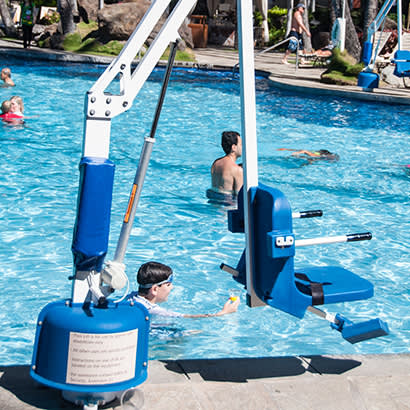
For an enhanced digital experience, read this story in the ezine.
Drowning is the leading cause of unintentional death among children ages 1 to 4. For children with autism, that range increases to ages 1 to 14. The risk of drowning surges when the individual has a disability. Adaptive and inclusive aquatics services save lives. Where should we begin when providing those services?
People-First Language
People-first language puts the person before the disability. For example, we may use “child who has autism” instead of “autistic child.”
Accessibility
The Americans with Disabilities Act (ADA) specifies two types of access we are required to provide: facility and program. Accessible pool features, such as lifts, must be maintained in operable condition. Offer adaptive-specific lessons along with accommodation services for inclusion cases to make your programming accessible.
Reasonable Modifications
A reasonable modification allows changes to a rule, policy or program that will enable a person to participate equally, within reason, given the patron’s disability. Public entities are required to provide reasonable modifications to individuals with disabilities unless doing so would pose an undue burden, either financially or as a fundamental alteration of the program. What is reasonable for some pools may be an undue burden for others.
To determine if a modification is reasonable, ask: Is it safe? Does it improve their ability to participate? Does it make their skills equal to others? Can we or they provide what they need?
Assessment Process
My agency follows a four-step assessment process: written, verbal, in-water and reassessment.
Have patrons fill out an assessment form before they register for lessons. This may cover the topics of swim history, abilities, communication styles, triggers, etc. Then verbally go over the form with them to clear anything up.
An in-water assessment takes approximately 15 minutes and simulates a lesson. Conduct this while others are in the pool and water structures are operating to create an environment similar to the actual lesson.
Reassessment is not always needed but applied if initial program placement isn’t the best fit.
Inclusive vs. Adaptive Programming
Inclusion is allowing a person with a disability to participate alongside participants who don’t have a disability. Individuals do not have to disclose their disability, as long as they meet program requirements.
Adaptive programs are designed specifically for those with disabilities. Some individuals prefer this type of program environment. Adaptive-specific programs can be used when inclusion isn’t successful. Best practices include lowering instructor-to-student ratios in group settings, having specialized trainings for adaptive instructors, incorporating more break times and offering group lessons at each level, including a swim team.
Intellectual Disability Population
When working with these individuals, there often is a need to manage behaviors. In these instances, you may refer to the Mandt System’s “Crisis Cycle” to identify behavior triggers and ways to avoid escalation.
Physical Disability Population
When working with individuals who have visual impairments, try hand-over-hand instruction, in-depth verbal instruction, and utilizing “tappers” to correct direction or prompt turns. When working with individuals who have hearing impairments, try Sign Language, gestures, white boards and laminated visuals.
You can accommodate a swimmer with a physical disability by modifying strokes or providing adaptive equipment. If a stroke is keeping them safe in the water and they have forward motion, that is a successful stroke. Adaptive equipment doesn’t need to be specialized — you can use what you already own and be creative.
Lauren Johnson Roweton, TRS, CTRS, is Adaptive Recreation Manager at Salt Lake County Parks and Recreation. Rebecca Barley Price, TRT, is Adaptive Recreation Manager at Salt Lake County Parks and Recreation.

